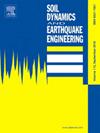Mutual information-based feature selection for estimating an appropriate vector-valued seismic intensity measure
IF 4.2
2区 工程技术
Q1 ENGINEERING, GEOLOGICAL
引用次数: 0
Abstract
Performance-based seismic design requires the use of probabilistic methods to predict the structural response to ground motion. This approach relies on the seismic demand model, which links intensity measures (IMs) with damage measures to evaluate structural response. It's important to choose the appropriate IM for a correct evaluation of performance. According to new research, vector-valued IMs with multiple scalar components may help make predictions more accurate by lowering dispersion and better capturing important ground motion characteristics. Despite this, it is still challenging to pick the appropriate vector-valued IM because it has to meet both efficiency and sufficiency criteria. This paper presents a novel approach based on information theory to tackle this challenge. The method involves picking the first and second components of the vector-valued information measure based on mutual information, conditional mutual information, and redundancy analysis. This way, the most useful information is found while redundancy is kept to a minimum, and the correlation between the vector-valued information measure components is taken into account. The method is tested on two reinforced concrete structures that are four and eight stories, using a set of 32 candidate scalar IMs and 60 ground motion records. The findings illustrate the efficacy of this method in identifying an appropriate vector-valued IM.
基于互信息的地震烈度特征选择
基于性能的抗震设计需要使用概率方法来预测结构对地面运动的反应。该方法依赖于地震需求模型,该模型将强度测量(IMs)与损伤测量联系起来,以评估结构响应。为了正确评估性能,选择合适的IM非常重要。根据新的研究,具有多个标量分量的矢量值IMs可以通过降低分散和更好地捕获重要的地面运动特征来帮助预测更准确。尽管如此,选择合适的向量值IM仍然具有挑战性,因为它必须同时满足效率和充分性标准。本文提出了一种基于信息论的新方法来解决这一挑战。该方法基于互信息、条件互信息和冗余分析,选取向量值信息测度的第一分量和第二分量。通过这种方法,可以在最小化冗余的同时找到最有用的信息,并考虑到向量值信息度量组件之间的相关性。该方法在两个四层和八层的钢筋混凝土结构上进行了测试,使用了一组32个候选标量IMs和60个地面运动记录。研究结果说明了这种方法在识别适当的矢量值IM方面的有效性。
本文章由计算机程序翻译,如有差异,请以英文原文为准。
求助全文
约1分钟内获得全文
求助全文
来源期刊

Soil Dynamics and Earthquake Engineering
工程技术-地球科学综合
CiteScore
7.50
自引率
15.00%
发文量
446
审稿时长
8 months
期刊介绍:
The journal aims to encourage and enhance the role of mechanics and other disciplines as they relate to earthquake engineering by providing opportunities for the publication of the work of applied mathematicians, engineers and other applied scientists involved in solving problems closely related to the field of earthquake engineering and geotechnical earthquake engineering.
Emphasis is placed on new concepts and techniques, but case histories will also be published if they enhance the presentation and understanding of new technical concepts.
 求助内容:
求助内容: 应助结果提醒方式:
应助结果提醒方式:


